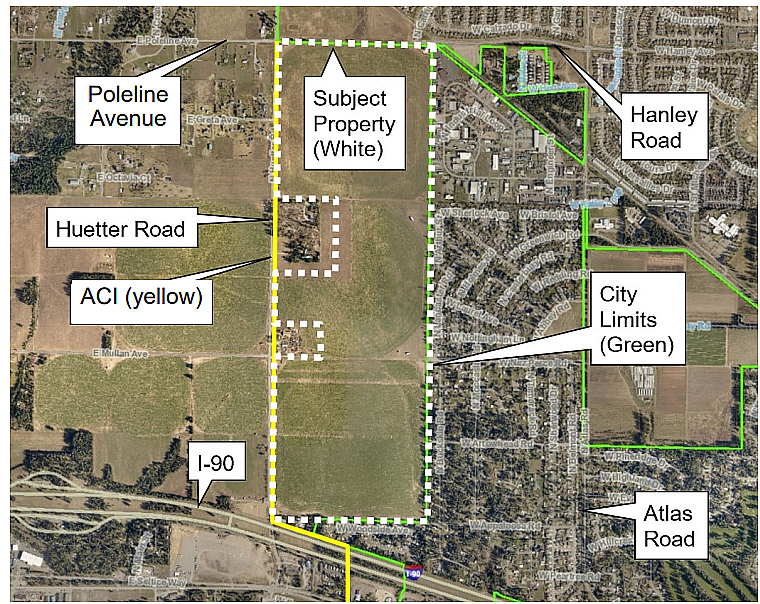Public hearing Tuesday on Coeur Terre requests
The developer of a major housing project in Coeur d’Alene is seeking three zone changes and two amendments to the development agreement. One of those amendments has caught the attention of some residents in the surrounding area.
“Recently we became aware of a requested change in the development agreement and zone change in the proposed Coeur Terre development just to the west of Indian Meadows,” wrote resident Suzanne Knutson, who lives on Appaloosa Road, which would be used as a connector to Atlas Road from the development.
“We have read the proposed request and it sounds like Kootenai Land Company would like a blank check to make any changes they want to,” Knutson continued. “We already feel that the city would like us to just go away and quit bothering them with our concerns. And it seems that this change in the development agreement, if approved, will leave us out of the process.”
A public hearing on the request is scheduled before the Planning and Zoning Commission at 5:30 p.m. Tuesday in the Coeur d’Alene Public Library Community Room.
The Kootenai County Land Company is planning Coeur Terre on about 440 acres on the city's western edge. The annexation and development agreement was approved by the City Council in March 2023 by a 4-2 vote, with councilors Dan Gookin and Christie Wood opposing. Numerous Indian Meadows residents spoke against the project, citing its impact on their homes and lives.
It calls for about 2,800 housing units, businesses, shops and restaurants, 18 acres of parks, a greenbelt, 4 miles of trails and land for two public schools.
The build-out process is estimated to take 20-30 years. The land is north of Interstate 90, south of the future West Hanley Avenue extension and east of Huetter Road.
Sean Holm, senior planner with the city of Coeur d’Alene, said the developer seeks to modify zoning on several portions of the site and amend the development agreement to allow zoning to govern land use more directly "rather than requiring additional public hearings for certain uses."
In an email to The Press, Holm outlined the changes:
Rezone about 14 acres from R-17 to C-17 to accommodate a mix of commercial and residential uses within the northwestern portion of Coeur Terre; rezone .8 of an acre from R-3 to C-17L to reflect the relocation of the city well site; and rezone about half an acre from C-17L to R-3 to reflect that a well site is no longer planned at this location (test drilling was unsuccessful), instead allowing for single-family residential use.
The two development agreement amendments:
Land Use Determination: Allow administrative approval of land uses consistent with the zoning districts rather than their conceptual master plan, eliminating the need for additional public hearings regarding use categories.
Sewer Infrastructure Timing: Align required wastewater improvements with actual demand as determined by the city’s wastewater utility department rather than adhering to a fixed schedule.
Holm wrote that “what the developer seeks is flexibility for the underlying zoning (allowed uses) that was approved at annexation.”
Nate Dyck, who also lives on Appaloosa Road, wrote, “It is understandable that the developer would ask for flexibility in the development agreement. However, I remain very concerned about Coeur Terre's impact on existing residents and infrastructure."
Dyck said that according to the Kootenai Metropolitan Planning Organization’s 2045 Traffic Modeling, there will be about 4,700 daily trips on Appaloosa (a sixfold increase) and about 11,000 daily trips on Nez Perce (a tenfold increase).
“The goal is not to be a roadblock to development, but to work with city leaders and stakeholders to find equitable solutions that maintain the safety and rural nature of our neighborhoods," Dyck wrote. "These concerns need to be addressed before use limitations are removed from the development agreement.”
Representatives of the Kootenai County Land Company told The Press that there is no effort being made to circumvent the process or leave out the public.
“This amendment simply clarifies that PUD, subdivision, and site plan applications for Coeur Terre can be submitted based on the land uses and product types allowed in the approved zoning district,” according to a written statement provided Thursday. “All future applications will still go through the usual city review, public hearing, and approval processes. Coeur Terre will follow all the necessary steps, including density limits, traffic and water studies, public hearings, and community input. Also, this change doesn’t affect any infrastructure requirements or other terms of the agreement.”
Hilary Patterson, community planning director for Coeur d’Alene, wrote that when the city initially drafted the development agreement, they thought the specificity of housing types in both graphic representation and verbiage would be beneficial, "but it didn’t account for changes in the market, new housing product types, what is currently allowed in the zoning code, or even possible future changes to the zoning code."
She said the city reached out to Post Falls on what level of specificity they include in their development agreements and “they shared that you don’t want to get so specific that every tiny change requires a public hearing but that you want enough specificity and certainty that everyone knows what to expect and can easily determine if a use is allowed by right or if it requires a public hearing."
“The requested amendments to the Development Agreement do offer that specificity and certainty, while not locking it so tight that a fourplex is allowed but not a triplex,” Patterson wrote.
She said public hearings will still be required for zone changes, Planned Unit Developments, and subdivisions with more than four lots, and any other significant amendments to the Development Agreement.
Knutson still has doubts.
“We see continued construction taking place throughout the city with very little, if any, regard for the existing residents and neighborhoods,” she wrote. “We have concerns about what will happen to our neighborhood and we are interested in hearing some solutions that take our concerns into consideration.”

